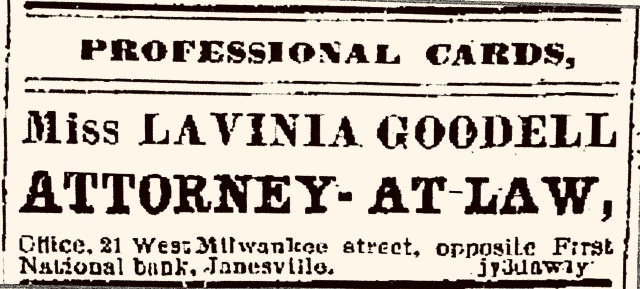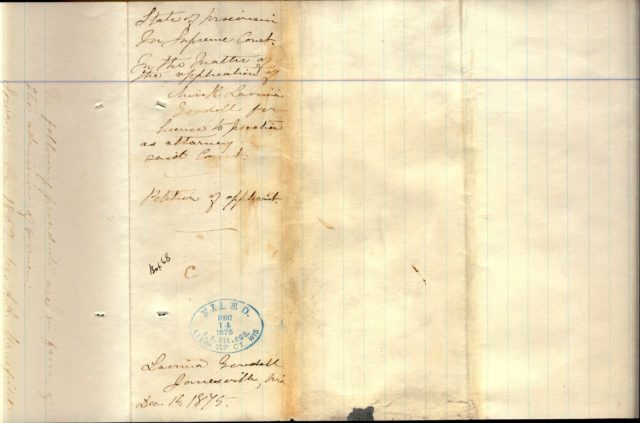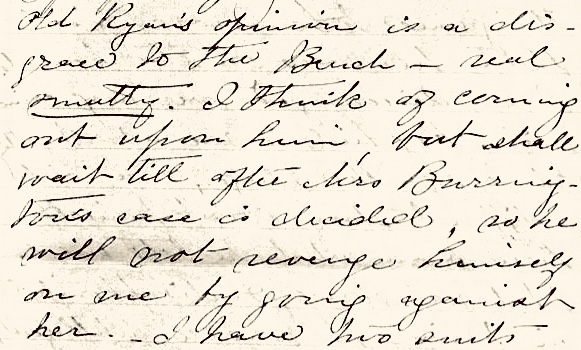Supreme Court Battle
If nature has built up barriers to keep Woman out of the legal profession, be assured she will stay out; but if nature has built no such barriers, in vain shall men build, for they will certainly be overthrown.
–Lavinia Goodell, April 22, 1876
Lavinia Goodell is best known for her epic battle against Edward Ryan over the right to practice in Wisconsin’s Supreme Court. In retrospect, their showdown seems almost preordained. Ryan was a prominent, brilliant lawyer who helped draft Wisconsin’s constitution and defended the Fugitive Slave Act. He was also a chauvinist with a very bad temper. He believed that a woman had a sacred duty to be a wife and mother. She must remain pure, avoid the uncivil world of politics, and let her husband vote on her behalf. Ryan became a justice (in fact, chief justice) of the Wisconsin Supreme Court on June 17, 1874.
That very same day, the Rock County Circuit Court admitted Lavinia Goodell to its bar, making her the first woman lawyer in Wisconsin. She was the brilliant daughter of a nationally renowned abolitionist, an accomplished editor and writer, a suffragist and champion of women’s rights. She opposed marriage because it made a woman subservient to her husband.

The Goodell/Ryan collision course began in 1875 when Lavinia and another lawyer represented Lydia Burrington, executrix of her husband’s estate, against an outlandish claim by the young and pretty Sarah Tyler. The all-male jury found for Sarah. Afterwards, Lavinia wrote in the Woman’s Journal: “Few, if any, doubt that the superior physical attractiveness of the girl won her the verdict.” Read more.
Lavinia wanted to appeal the Burrington decision to the Wisconsin Supreme Court, but she had to be admitted to practice there first. She drafted a motion explaining that the existing law allowed women lawyers to appear in all Wisconsin courts. She also argued that women lawyers could best represent women’s legal interests. And by creating competition for male lawyers, women would improve the quality of the profession. Lavinia had to watch while a male lawyer read her motion to the Wisconsin Supreme Court. She described Chief Justice Ryan as being “mad as a bull when he sees a red rag.” “He bristled all up when he saw me, like a hen when she sees a hawk, and did not recover his wonted serenity during my stay,” she wrote.

Ryan wrote the unanimous decision denying Lavinia the right to practice in the Wisconsin Supreme Court. He held that Wisconsin law only permitted men to be lawyers. He declared that courtrooms were too coarse for women. Indeed, “[t]he law of nature destines and qualifies the female sex for bearing and nurture of the children of our race,” he said. The legal profession was for men only. By becoming a lawyer, a woman would “unsex” herself and commit “treason against nature.” Read more. As a result, a male lawyer had to present the Burrington appeal to the Court.

Lavinia called Ryan’s decision “a disgrace to the bench and the bar” and refused to take “no” for an answer. She waited until Lydia Burrington prevailed in the Wisconsin Supreme Court and then wrote a rebuttal to Ryan’s decision to deny her admission. It was published around the country. Even the press poked fun at Ryan’s sexist view of women. Read more. Lavinia also drafted a law allowing women to practice law in Wisconsin and lobbied for its passage. On March 8, 1877, she succeeded. An all-male legislature passed the bill, and a male governor signed it.

Lavinia had opened Wisconsin’s legal profession women, but she still had unfinished business with the Wisconsin Supreme Court. In 1879, she filed an appeal in Ingalls v. State, and again petitioned for admission to that court so she could argue the case herself. This time, citing the new law she drafted, four justices voted to admit her to the Wisconsin Supreme Court’s bar. Chief Justice Ryan dissented without explanation. Read the decision here. Shortly before her death on March 31, 1880, Lavinia learned that she had won the Ingalls appeal. She told her sister it was a “pure woman’s victory,” meaning that it required no assistance from a male attorney.

A few months after Lavinia’s death, as though concluding this chapter of Wisconsin’s legal history, Chief Justice Edward Ryan passed away as well. CB
Sources consulted: The Blue Book of the State of Wisconsin for 1881, p. 258 (David Atwood, State Printer 1881); Joseph A. Ranney, “Chief Justice Edward G. Ryan: A World in which Nothing is Perfect,” Sept. 1, 2002 (available here); Maria Goodell Frost, “Life of Lavinia Goodell,” (unpublished manuscript at Berea College); Lavinia Goodell, “Should Women Practice Law in Wisconsin,” Woman’s Journal, Vol. 17, 4/22/76; Lavinia Goodell’s letter to Sarah Thomas, 2/24/76; Lavinia Goodell’s Diaries, Nov. 27, 1875 though December 15, 1875; Tyler v. Burrington, 39 Wis. 376, (1876); Ingalls v. State, 48 Wis. 647, 4 N.W. 785 (1880).